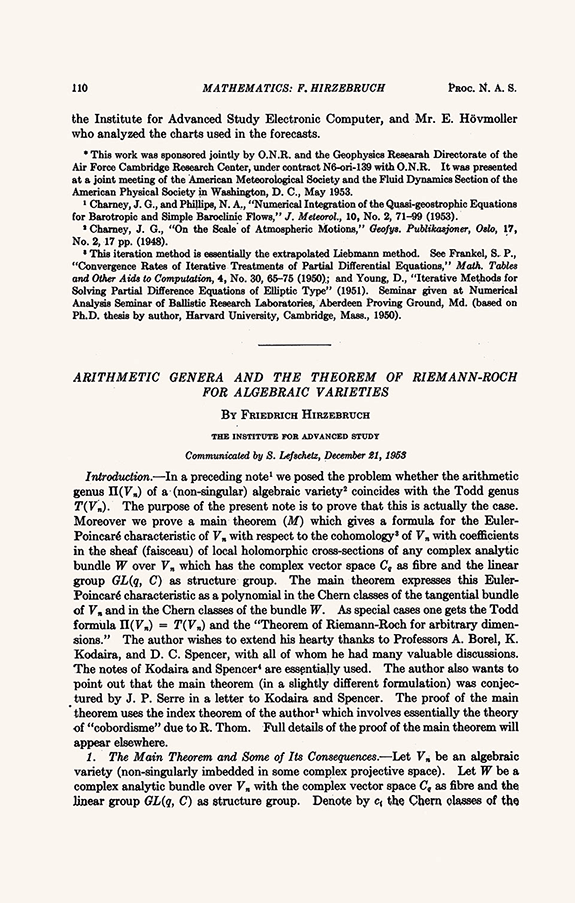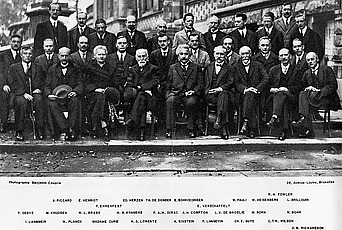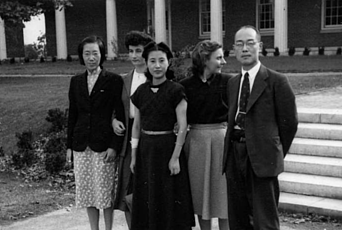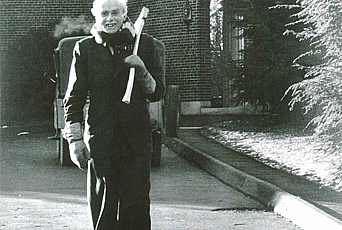1953

In many different ways, 1953 was an exciting year. In February–March, at the Cavendish Lab in Cambridge, England, James Watson and Francis Crick discovered the structure of DNA molecules and its double-helix geometry. This discovery was announced in Nature in April and hit the news during the second half of May. Several newspaper articles in the English and American press at the time celebrated the work of Watson and Crick as closing in on the secret of life. This enthusiasm was vindicated by later developments, so that the publication of Watson and Crick’s paper1 is now regarded as one of the most important scientific events of the twentieth century.
At the same time, a British expedition was on the slopes of Mount Everest attempting the first climb to the top of the highest mountain on earth, which had, until then, defeated all challengers. The expedition set up base camp in March and then worked its way up the mountain. After a failed summit attempt by a different pair of climbers, Edmund Hillary and Tenzing Norgay finally conquered Mount Everest on May 29, 1953. News of their success reached the Western world on June 2 and was a front-page story. It so happened that June 2 was also Coronation Day in England, when Queen Elizabeth II was crowned after having ascended to the throne upon the death the previous year of her father, King George VI. The New York Times called the news of Hillary and Tenzing’s exploit a “coronation gift.”
In that spring of 1953, Friedrich Hirzebruch was hard at work at the Institute in Princeton. He had arrived from Germany the previous summer for what would become a two-year stay and had immediately immersed himself in learning sheaf theory, algebraic geometry, and characteristic classes under the guidance of Kunihiko Kodaira and Don Spencer of Princeton University. By the spring of 1953, Hirzebruch was trying to solve what he thought of as the Riemann-Roch problem: to formulate and prove a far-reaching generalization of the nineteenth-century Riemann-Roch theorem, extending it from algebraic curves to algebraic varieties of arbitrary dimensions. The setting was sheaf cohomology and the goal was to find a formula for certain Euler characteristics in sheaf cohomology in terms of Chern classes.

Just a couple of years earlier, in 1950, William Hodge had proved that the sum of all the Euler characteristics that Hirzebruch was looking at equals the signature of the underlying manifold. The signature is a simpler invariant than sheaf cohomology and makes sense for a manifold that need not be an algebraic variety. It had been introduced in this more general context by Hermann Weyl as early as 1923. Hirzebruch understood that if the purported Riemann-Roch theorem were true, then, by Hodge’s theorem, the sum of all the expressions in Chern classes on the right-hand side would have to reduce to an expression in Pontryagin classes. This would give a formula identifying the signature of a manifold with an expression in its Pontryagin characteristic classes.
By May of 1953, Hirzebruch knew what this formula had to be, and he had verified it in many cases. He had thus arrived at conjecturing the so-called signature theorem. On Coronation Day, June 2, 1953, in the library of the Institute, Hirzebruch read the note by René Thom in the Comptes Rendus of the Paris Academy announcing his calculation of the oriented bordism ring (tensored with Q). With this calculation in hand, the proof of the signature theorem was complete, since both sides are bordism-invariant and Hirzebruch had already verified the theorem for Thom’s generators of the bordism ring. Even if Hirzebruch had been a subject of Queen Elizabeth II, rather than being German, I very much doubt that anyone would have considered the signature theorem a coronation gift.
But then, unlike Hillary and Tenzing, Hirzebruch was not at the summit yet. Rather, the proof of the signature theorem announced in the Proceedings of the National Academy of Sciences2 became his advanced base camp for the final push towards the general Riemann-Roch theorem. During that push, Kodaira shared with Hirzebruch a letter he had received from Jean-Pierre Serre, in which Serre proposed an even more general version of Riemann-Roch than Hirzebruch had envisaged. Serre had verified his conjecture in many cases, and Hirzebruch saw immediately that Serre’s more general formulation reduced to the special cases he himself had been focusing on by means of the splitting principle he had developed. Finally, around December 10, Hirzebruch completed the proof of what we now call the Hirzebruch-Riemann-Roch theorem. This proof, announced in PNAS3 and submitted through Solomon Lefschetz of Princeton University on December 21, 1953, used a complicated induction procedure to ultimately reduce the general Riemann-Roch theorem to the signature theorem that Hirzebruch had proved six months earlier.
Hirzebruch’s work at the Institute in 1953 has had a profound influence on mathematics, and even on theoretical physics, over the last sixty years. In 1956, John Milnor, then at Princeton University, used the signature theorem to prove the existence of exotic spheres, giving rise to the new field of differential topology. The Riemann-Roch theorem was soon generalized further by Alexander Grothendieck and became a cornerstone of the development of algebraic geometry. In 1962–63, the signature theorem and the Riemann-Roch theorem were the motivating examples that led Michael Atiyah and Isadore Singer to the formulation of their index theorem, which brought together previously unrelated areas of mathematics and later played an important role in the modern interactions between geometry and physics. The first proof of the index theorem closely followed Hirzebruch’s approach to Riemann-Roch.
All these methods and results are ubiquitous in present-day mathematics. As just one example, consider the first application of gauge theory to four-dimensional topology, published by Simon Donaldson in 1983, exactly thirty years after the proof of the signature theorem. Donaldson’s argument makes crucial use of the Atiyah-Singer index theorem and of the bordism-invariance of the signature, which was also crucial for Hirzebruch’s proof of the signature theorem. Donaldson’s breakthrough led to the discovery of exotic smooth structures on Euclidean four-space, one of the most startling events in differential topology since Milnor’s discovery of exotic spheres. Nowadays, low-dimensional topology is dominated by theories that are outgrowths and variants of Donaldson theory.
The importance of Hirzebruch’s work for mathematics is comparable to that of Watson and Crick’s work for the life sciences. Both have transformed their respective fields, both have forged links between previously unrelated fields, and both have spawned new developments without which the modern scientific landscape would be unimaginable.
The importance of Hirzebruch’s work for mathematics is comparable to that of Watson and Crick’s work for the life sciences. Both have transformed their respective fields, both have forged links between previously unrelated fields, and both have spawned new developments without which the modern scientific landscape would be unimaginable.
Neither Hirzebruch nor Watson and Crick worked in isolation. Like Hillary and Tenzing, whose achievement would not have been possible without the collaboration and support of many others sharing their goal—and sometimes competing to get there first—Watson and Crick’s work would not have been possible without their interaction with Linus Pauling, Maurice Wilkins, Rosalind Franklin, and Raymond Gosling. In a similar vein, Hirzebruch’s work would not have been possible without his interactions with Kodaira, Spencer, Thom, and Serre. However, Hirzebruch’s work did not lead to a controversy parallel to the famous dispute arising from Watson and Crick’s use of the X-ray data of Franklin and Gosling. This is not because mathematicians are not competitive—quite the opposite is true—but was probably due to Hirzebruch’s generous personality and his always gracious acknowledgments of the contributions of others. All his life, until he passed away in May of 2012, Hirzebruch was on warm and friendly terms with his colleagues. He was forever grateful for the opportunity to come to the Institute and to have been welcomed by and to have collaborated with colleagues he respected and admired.
1. J. D. Watson and F. H. C. Crick, “Molecular Structure of Nucleic Acids: A Structure for Deoxyribose Nucleic Acid,” Nature, 171 (1953): 737–38.
2. F. Hirzebruch, “On Steenrod’s Reduced Powers, the Index of Inertia, and the Todd Genus,” Proceedings of the National Academy of Sciences, 39 (1953): 951–56.
3. F. Hirzebruch, “Arithmetic Genera and the Theorem of Riemann-Roch for Algebraic Varieties,” Proceedings of the National Academy of Sciences, 40 (1954): 110–14.


